The Empire of The Infinite Sun
Basic Information.
Name - Longhand: The Empire of the Infinite Sun.
Name - Shorthand: The Empire/The Infinite Sun.
Government: De Jure: Alliance of three separate, Absolute and Theocratic Monarchies. De Facto: Absolute, Theocratic Monarchy.
Current Monarchs: Axayacatl XIV (Technochtitlan), Ixtlilxochitl XI (Texcoco), Tezozomoc XIII (Tlacopan).
Motto: "The Gods Demand, We Obey."
Denomym: Aztec.
Currency: Golden Bean.
Population: 20 Billion (Rough estimate).
Worlds Under Influence: 7.

A celebratory gathering at the temple of a planetary capital city after a successful campaign.
Basic Information.
Name - Longhand: The Empire of the Infinite Sun.
Name - Shorthand: The Empire/The Infinite Sun.
Government: De Jure: Alliance of three separate, Absolute and Theocratic Monarchies. De Facto: Absolute, Theocratic Monarchy.
Current Monarchs: Axayacatl XIV (Technochtitlan), Ixtlilxochitl XI (Texcoco), Tezozomoc XIII (Tlacopan).
Motto: "The Gods Demand, We Obey."
Denomym: Aztec.
Currency: Golden Bean.
Population: 20 Billion (Rough estimate).
Worlds Under Influence: 7.

A celebratory gathering at the temple of a planetary capital city after a successful campaign.
Introduction
In the depths of space, an empire shines furiously and brightly, in contrast, nay; defiance of the cold and emotionless darkness. An empire that stretches from star to star, world to world, city to city. Bound in blood, fire and faith, this civilization has stood proudly and indomitably for centuries untold, almost unchanging ever since strode upon the great void riding atop it's mighty starships. It is an empire of men, ruled by priests and administrators, but shaped in the form of their glorious and terrible Gods. These Gods are many, and their iconography can be found scrawled into every nook and cranny wherever their dominions are relevant. Above the doors of a humble farmer's house, one may find the likeliness of Chaac, God of rain, storms and patron of agriculture, just as one would find the images, statues, altars and legends of Ek Chuaj, the Merchant God, carved, painted and plastered around the market places of the cities. For thousands of years, the Empire of the Infinite Sun has counted each of their blessings as a gift from each of their Gods, forever faithful that as long as they continue to serve diligently and wisely, the people of the Infinite Sun and the rest of the universe will know prosperity until the end of this age. One only need to see how wide and tall the people build their magnificent and imposing temple-pyramids and how they paint them with bright and joyously coloured dyes to know of their piety and passionate devotion. However, these blessings, like all things, must come at a price. The Gods sacrificed much to create this world and they sacrifice all the more to make the lives of those who live at least bearable. The Gods gave blood to the mortals, the mortals must give blood in return. In great, ornate barracks, elite Jaguar and Eagle warriors train day after day to lead the common warriors of their people into righteous battle. On fields of crimson fire and blackened earth the Blazing Host surges forward, crying war chants in a maddening chorus as they slaughter all who stand against their tide and drag away their offerings to the Gods. The Burning Armada flies ahead, incinerating and blasting away with fire and laser what the Host cannot overwhelm through sheer number and strength. In the depths of space, an empire shines furiously, like the armies and fleets of death and divine devotion that pour from its worlds like fountains of war, and brightly, like colour of the paint and blood offerings of the temples that stand in high stature at the center of every city, in contrast, nay; defiance of the cold and emotionless darkness, like the cold and emotionless worlds it leaves in its wake.

“The Gods Demand, We Obey”
Government
The Empire of the Infinite Sun is run by a complex, but somewhat straightforward systems of nobles, administrators and priesthood. From the three worlds that now serve as the seat of the Empire, Tenochtitlan, Texcoco, and Tlacopan (Tenochtitlan being chief among them), the three Emperors of the Infinite Sun command the Empires military, decree empire-spanning legislation, receive tribute from the their respective colonies and coordinate the day-to-day functions of administrating their own respective worlds. The Emperors are bound together by the ancient treaties and laws of the Triple Alliance, but in truth, it is the Emperor of Tenochtitlan, wielding the most powerful domain, that commands the Emperors and thus the Empire of the Infinite Sun. Worlds not ruled directly by the Emperors are ruled by planetary Kings, who owe tribute and allegiance to the Emperors, while they hold some autonomy, it is merely to speed the process of planetary bureaucracy. In the end the Kings are subservient to the Emperors of the Triple Alliance, who are in turn subservient to the one who sits in the throne of Tenochtitlan. Assisting the Kings and Emperors in ruling their respective domains is an intricate web of Provincial Governors and Administrational Scribes, both have a high place in society as the Provincial Governors assist in carrying out the commands and overseeing the lands of their Emperors and Kings while the Scribes are the ones responsible for writing and filing the necessary paperwork to keep the gears of bureaucracy well oiled and greased to function as intended. Governors and Scribes are appointed by their respective higher-ups, Governors are appointed by Kings and Emperors, while Scribes are appointed by Governors, if they are Provincial Scribes, and the Kings/Emperors if they are Imperial Scribes. Another major faction in governance is the religion of the Infinite Sun and it's influence in society and governance. First, there is the Priesthood, with it's own structure and hierarchy of Priests and Scribes, who oversee and coordinate the traditional rituals and celebrations of the people of the Infinite Sun. Through this function, the Priesthood plays a large part in the vitality of the Empire's culture and way of life and thus are held in high regard from the lowliest slave to the Emperors of the Triple Alliance. Secondly, is the Kings and Emperors themselves, who are the planetary heads of the Empire's religion and hold much power through this position as they are strained from it. The Kings and Emperors appoint the upper echelons of the Priesthood and thus hold sway over the course of it's leadership. However, the Kings and Emperors are obligated to hear out the opinions and complaints of the Priesthood, for the legitimacy of the Kings and Emperors descends from Divine Right, the Will of the Gods. As such, any King or Emperor who defied the Priesthood would in effect be denying the Gods and forfeit their right to rule. As such, whenever a King or Emperor disgraces their lineage as such, or pass on without leaving an heir, the upper echelons of their respective Priesthood appoint a new bloodline to ascend and sit upon the vacant throne. Just as the Kings and Emperors command the Empire's faith, so to does the Empire's faith control the Kings and Emperors.
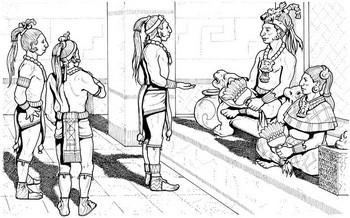
Depiction of an ancient Governor of the Empire of the Infinite Sun and his chief Scribe listening to the grievances of local subjects.
Economy
The economy of the Empire of the Infinite Sun is a strange mixture of complete government control over certain sectors, free market control over others and a mixed market standing in between. All lands within the Empire are considered, by the Divine Right of the Kings and Emperors, property of the government at all times. Since this land is neither bought or sold, it can only be acquired for private use by rent, such is the foundation of the Empire's current revenue system. This has resulted in certain sectors of the economy, infrastructure, terrestrial transportation and communications chief among them, completely dominated by the state sector of the economy. As such, managing the growth and development of cities is one of the primary concerns of Governors and Scribes of the Infinite Sun. However, many private industries stand in spite of the government's monopoly on land ownership; farmers, miners, fishers, hunters and such as simply rent out lands from the local governors and manage to make a profit out of selling their goods nonetheless. However, due to the government's power to raise rents and evict tenants at will, there is still a large amount of government involvement in these sectors. Sometimes, it is a Governor or King trying to direct the course of the local economy by raising rents in some sectors and lowering rents in other sectors. Other times, it is a Governor or King evicting tenants due to the corruption of either the tenants themselves, or the Governor, as is what happens on occasion when government involves itself in economics. However, while the government command monopoly on all land, it does not hold any control over the ebb and flow of actual goods. This quirk in Infinite Sun economics has resulted in the occupation of merchants and salespersons incredibly profitable as no form of sales tax exists within the Empire. This has resulted in the creation of Merchant Guilds, organized in the interests of increasing profits and securing their occupation from government control. This has resulted in the guilds being quite powerful economically as they control almost all planetary, interplanetary and interstellar trade within the Empire and secure their position by cutting off trade to any Governor, King and even Emperor who has attempted to do so. Another aspect of Infinite Sun economics is the presence of slavery, which both government and private sectors of the economy utilize. Slaves usually prisoners of war, citizens who could not pay their debts and were sold to slavery to pay them off and children sold into slavery to pay off the debts of parents. While slaves in the Empire can purchase their freedom, and enjoy many of the goods offered by the Empire such as property and even their own slaves, they still make up a significant portion of the Empire's workforce and assist greatly in projects that would be considered expensive in monetary value to other civilizations.

Artist's depiction of the infamous theft of Emperor Tizoc XII's treasury. Stories of which still capture many people's imaginations of the thief's cunning and of the great riches that was the thief's prize.
Culture
The first aspect of Infinite Sun culture that's worthy of note is how closely religion and culture are tied together. Celebrations and ceremonies are public events organized by the local priests and are more often than not religious in nature. However, not everything that transpires in these gatherings are related to the faith, displays of the Empire's culture such as public recitals of poetry from renowned poets and festivals filled with local music and cuisine also occur regularly, both as part of religious ceremony and indulgent celebration. The focus religion is not limited to these celebrations, though, many sculptors across the empire carve stone into statues, idols and totems of the Gods, in hopes that their displaying of these icons will garner the owners the respective God's blessing. The iconography of the Gods can be found imprinted and painted into the walls, windows and doors of structures whose function or purpose is relevant to said God's domain. The people of the Empire do not turn their backs from the temple shrines as they descend the temple steps, literally refusing to turn their backs on their inspiring and horrifying deities. The Empire itself wages war after war to bring more and more sacrifices and offerings to the alters of their blood-soaked temples. Indeed, if there is any certainty in the Empire of the Infinite Sun, it is that the Empire itself and it's faith cannot be spoken without speaking of the other. However, this being said, there are elements of the Empire's culture that one could consider 'secular' in one way or another. Firstly, it is important to remember that while poets, sculptors and the like make a good part of their living off religious celebration and articles of faith, they also make their livelihoods through secular means as things such as poems are held in high regard by the Empire's people and sculptors dedicated just as much grandiose time and effort to traditional calendars as they doe carvings of their Gods. Another secular institution is the class system, which, for the sake of simplicity, can be divided into four classes. The first is the noble class, which makes up roughly a fifth of the population, these individuals are usually descended from privileged lineages and are typically granted the best the Empire has to offer. Those of noble birth are given the best education, the highest standard of living and are the preferred choice for appointments to government positions. However, how high a nobleman my stand depends on the impression he has left in society as even the direct children of Emperors can be shoved into the position of lowly scribe and see the throne of their parent given to a distant cousin if they fail to prove themselves worthy successors. This brings a degree of meritocracy to the otherwise privileged lives of the nobles. The second class is the commoner class, a rather self-explanatory title, that makes up around three fifths of the Empire's people. Those of the common, otherwise known as non-noble, birth live modest lives as the backbone of society, from farmers to artisans, from soldiers to traders, the path of the commoner is one of varied servitude to the nobility and enjoying what pleasures they can find or purchase between their duties. The third class is the slave class, another straightforward title for the remaining tenth of the Empire's civilization. The slaves are considered the lowest class of society, as one usually becomes a slave due to unpaid debts, being a prisoner of war and other such things looked down upon by the nobles and commoners. Fortunately, it is also the only class one has the potential to escape, as slaves can earn their freedom through work and wealth. However, this is rarely the case and slaves usually find their only respite of their lives of grueling servitude to their owners is the material comforts that society still allows them to purchase at their own leisure and that their children will live free as those born by members of the slave class are considered members of the commoner class. The fourth class takes up an almost invisible sliver of the population, but are an important one nonetheless and are worthy of note through it, this is the merchant class. This class is possibly the only class earned completely through merit, as only the richest and most influential tradesmen are considered part of it. This class is held in high regard by even the nobility, for while it lacks any political power, the members of the merchant class exert their presence through their vast sums of wealth and control over the trade of the Empire. These class divisions usually emphasizing the familial heritage of the individual has also resulted in a culture of duty to one's family as much as to their religion and society, with entire families of familiar linage organized into great houses, known as Calpulli, under the guidance and wisdom of a familial chief. Like the merchants, while the Calpulli held no political power they held great sway over the personal lives of their family members compared to the government, such as the negotiation and arranging of marriages of family members, job opportunities provided by the chief and such as. Each Calpulli even manages it's own, small temple to it's own God to grant offerings in exchange for further blessings upon the Calpulli. Finally, there is the presence of the Empire's warrior culture, which developed due to the realities of worshipping Gods who demanded blood sacrifices and the Empire's decision to sate this demand by offering the blood of other civilizations. Firstly, service in the military is something members of all classes, except slaves, can partake in and it allows the promotion of commoner soldiers into positions usually reserved for nobles. While it isn't exactly an ideal example of class mobility, as most commanders are of the nobility, limiting opening for commoners and nobles who join the military are already eligible for branches of the military that commoners would have to work to enter, such as the Eagle and Jaguar Warriors, it gives commoners with a penchant for warfare a chance to raise their standing in society. Needless to say, the elite warriors of the Infinite Empire are held in high standing as they are the ones who gather sacrifices for their people's Gods, a duty that cannot be overstated in its importance to the people of the Infinite Sun and the warriors who bring the most sacrifices are highly rewarded. As such, a culture of proving oneself in battle for individual glory also exists within the military itself, as commoner soldiers seek to capture enough sacrifices to join the elite branches of the military and said elite branches are filled with warriors bent on improving their status within the Empire and in the eyes of the Gods. While this culture may impede grand strategy and tactics within the Empire, it creates a high level of individual initiate within commanders and soldiers of the Empire's armed forces. However, this small beacon of class mobility is only available for men within the Empire, which brings us to the topic of gender divisions within the Empire's culture. From birth, boys and girls would be taught life skills from the parents of their respective genders, the father would teach his sons and the mother her daughters. A boy's upbringing and girl's upbringing were mostly alike, men and women within the Empire were both expected to take up occupations and were roughly equal in job opportunities. The difference came when the divisions within the class and military systems came to relevance. Boys are all taught how to fight from their fathers and if they were of the nobility or of exceptionally wealthy merchants, they would be given more advanced training in war, reading, mathematics and such as. However, girls are not given these opportunities in their education, with a slight emphasis on domestic and household chores and maintenance instead. Needless to say, these opportunities grant men in society positions in military, governance and general leadership denied to women. As such, one can indeed call the Empire of the Infinite Sun a patriarchal society, one that shows no signs of changing any time soon.
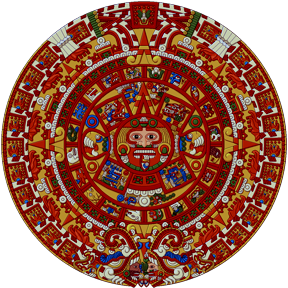
Example of a fully carved and painted Calendar from the Empire of the Infinite Sun.
History
The history of the Empire is long and many details have been forgotten over the ages, however, relatively much has been preserved in spite of the weight of ages placed upon the collective memory of the Empire. This is primarily due to the diligence of the Empire's record-keepers, carving tome after tome of historical knowledge into stone tablets and storing them into libraries that stretch long and wide. However, the destruction of libraries by accident, natural hazards or simple strife has created gaps in the memories of the Empire's civilization, but a cohesive narrative of the Empire's birth and growth remains intact. The Empire started as a single city-state, Tenochtitlan, that grew into being the leader of a powerful alliance involving two other city-states, Texcoco and Tlacopan, known as the Triple Alliance, which still officially stands to this day, although the power of Texcoco and Tlacopan is greatly reduced compared to that of Tenochtitlan. For centuries, this Empire prospered as it collected tribute from neighboring city states and dominated the region with it's fierce warriors. However, this Empire only controlled an insignificant portion of the world it sat upon, and was in no place to become an interstellar power anytime soon. Then, and this is where records get somewhat spotty, a wise and mighty God is said to have descended from the heavens and bestowed great gifts upon the people of Tenochtitlan. These gifts came in the form of knowledge, knowledge of the stars and worlds beyond, knowledge of how to reach these worlds and knowledge on how to conquer them. Bolstered with this great knowledge, the borders of the Triple Alliance's domain exploded as city after city fell to the warriors of Tenochtitlan and it's allies. The temple districts were stained in sacred crimson for months on end as sacrifices were gathered from each city that fell. Soon, the Triple Alliance crossed even the great oceans of their world and offered the once-glimmering civilizations that stood upon those foreign continents as massive charnel houses to the Gods. After years of holy conquest, the Triple Alliance found itself covering every corner of its world, but it could not stop there. Charts of the heavens and designs of vessels to navigate them, kept sealed for that moment since the God of Knowledge bestowed them ages ago, were finally opened and the Empire of the Infinite Sun was born in the fiery conquest of alien worlds. The Triple Alliance was re-ordered, Tenochtitlan would reign over the homeworld of the Infinite Sun, while Texcoco and Tlacopan were given subordinate positions in the Empire's two first colonies, this marked the era where the Emperor of Tenochtitlan ruled the Triple Alliance indefinitely. While Tenochtitlan's allies protested this rearrangement, a quick show of military force soon cowed the two, now lesser, city-states. And so, for centuries from this point, the Empire of the Infinite Sun has blazed across the stars in a hungry and eternal search for new worlds to offer to the thirsting universe. From the seat of Tenochtitlan, the fleets and armies have marched under the command of their Emperor, returning with the peoples of entire civilizations tucked under their arms and in their ships to quench the thirsting Grand Altar of Temple of the Infinite Sun with their blood. Such has been the way of the Infinite Sun's namesake, eternal, unchanging and dangerous to all who stray too near.

Drawn recreation of the founding myth of the first city of the Empire. It was said that the people of the Infinite Sun were banished from their homeland and forced to find a new one. After years of struggling to found a new home, the people were given a vision of a mighty eagle perched upon a cactus eating a snake and saw it as a sign of where to found their new home. It wasn't long before the people found a great lake sprawled out before them and in the middle of that lake was the very same eagle, perched on the same cactus, devouring the snake. The people embraced this sign and built their home on the largest island within the lake. This home grew into a great city, Tenochtitlan, which is now the name of the world which holds the seat of power within the Empire of the Infinite Sun. Today, the vision is used as the seal of the Emperor of Tenochtitlan himself; an eagle, eating a snake, perched on a cactus.
Military
The military of the Empire of the Infinite Sun is a gargantuan beast. The central government of Tenochtitlan focusses the majority of its effort to maintaining and expanding the fleets and armies of the Emperor. This is primarily due to the religion of the Infinite Sun, that the Gods gave blood to create the universe and require the blood of mortals as a price to maintain creation. While some religious rites are simple blood seals, the cutting of a hand and offering what blood drips down from it, others require an entire heart from an individual. Because of this, the Empire is always sending forth campaigns into the void of space to find new peoples and worlds to offer to their Gods and to guarantee the continuity of reality. While this has made the military of the Infinite Sun quite strained, the effort is lessened by the warrior-culture this belief has produced. Every male child is taught how to fight to some degree, bolstered by an elite core of warriors who descend from nobility or who have proven themselves greatly in battle and dedicate their lives to combat. The result is a military that can summon forth legions of conscripts of adequate skill on a whim and still manage to support them with detachments of elite warriors. However, this warrior culture has a curse that comes with it's boons, as each warrior fights to prove his own worth and glory to the Gods and don't function as cohesively as a unit compared to other militaries. This does result in greater initiative among individuals, but at the expense of collective might. These organizational issues, combined with the Infinite Sun's relatively primitive technology compared to many civilizations has resulted in a number of defeats in spite of the vast numbers of warriors the Empire can bring to bear. Fortunately, the inadequacies of the armies are usually compensated by the fleet, whose purpose is to destroy through orbital firepower what the army cannot overwhelm through sheer force of manpower.
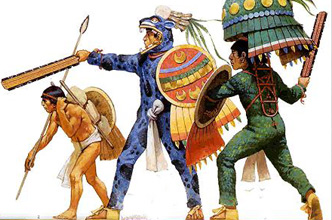
Infinite Sun warriors going through monthly training rituals in traditional garb.
The Empire
The Empire itself is stretched over seven worlds across seven star systems. The most heavily developed worlds are Technochtitlan, Texcoco and Tlacopan, also known as the Thrones of the Triple Alliance, and are roughly the centers of political, economic and military power within the Empire of the Infinite Sun. All other colonies are simply satellites to the might of the Throne Worlds, although they do contribute to the military and economic power of the Empire as a whole and help ease the burden of carrying the Empire's massive population of almost a hundred billion individuals. All worlds within the Empire have also been heavily terra-formed to resemble the homelands of the Empire's people. Hot and humid rainforests span across every continent with metropolises of brightly painted stone and vast blue lakes and Cenotes breaking dominance of the greenery. This lack of biodiversity has made the people of the Infinite Sun very uncomfortable in worlds not of their own control, as many lack the rainforests and such things they have grown quite accustomed to, but it has made travel within the Empire all the more easy as each world is almost identical to the other in terms of biology and climate.
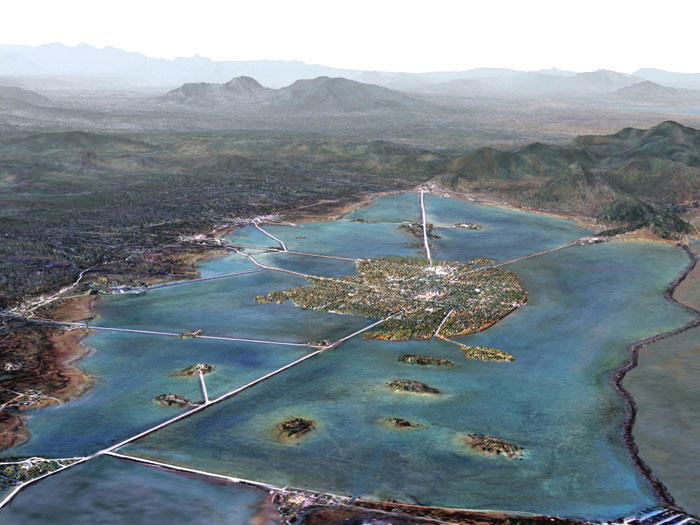
Example of an Infinite Sun colony from a high vantage point.
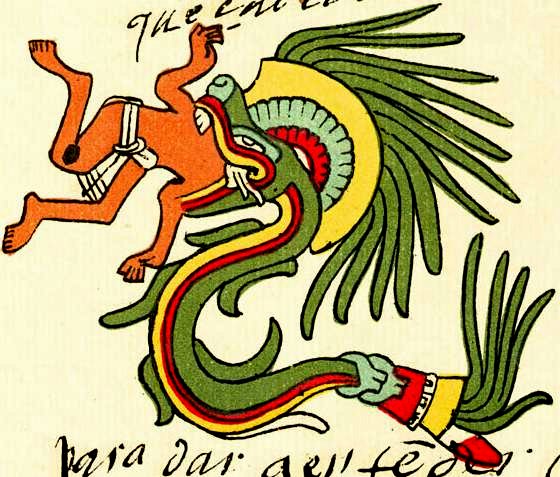
Depiction of the 'Sovereign Feathered Serpent,' a well-known deity within the Empire of the Infinite sun.

